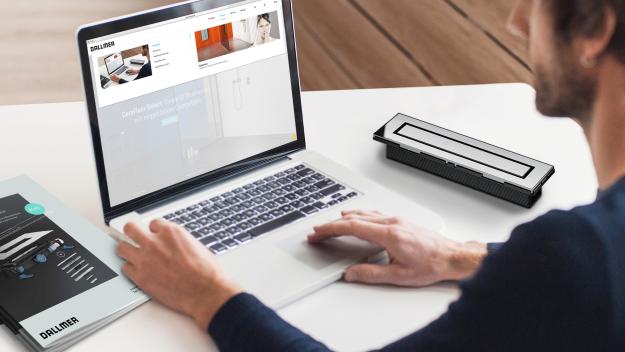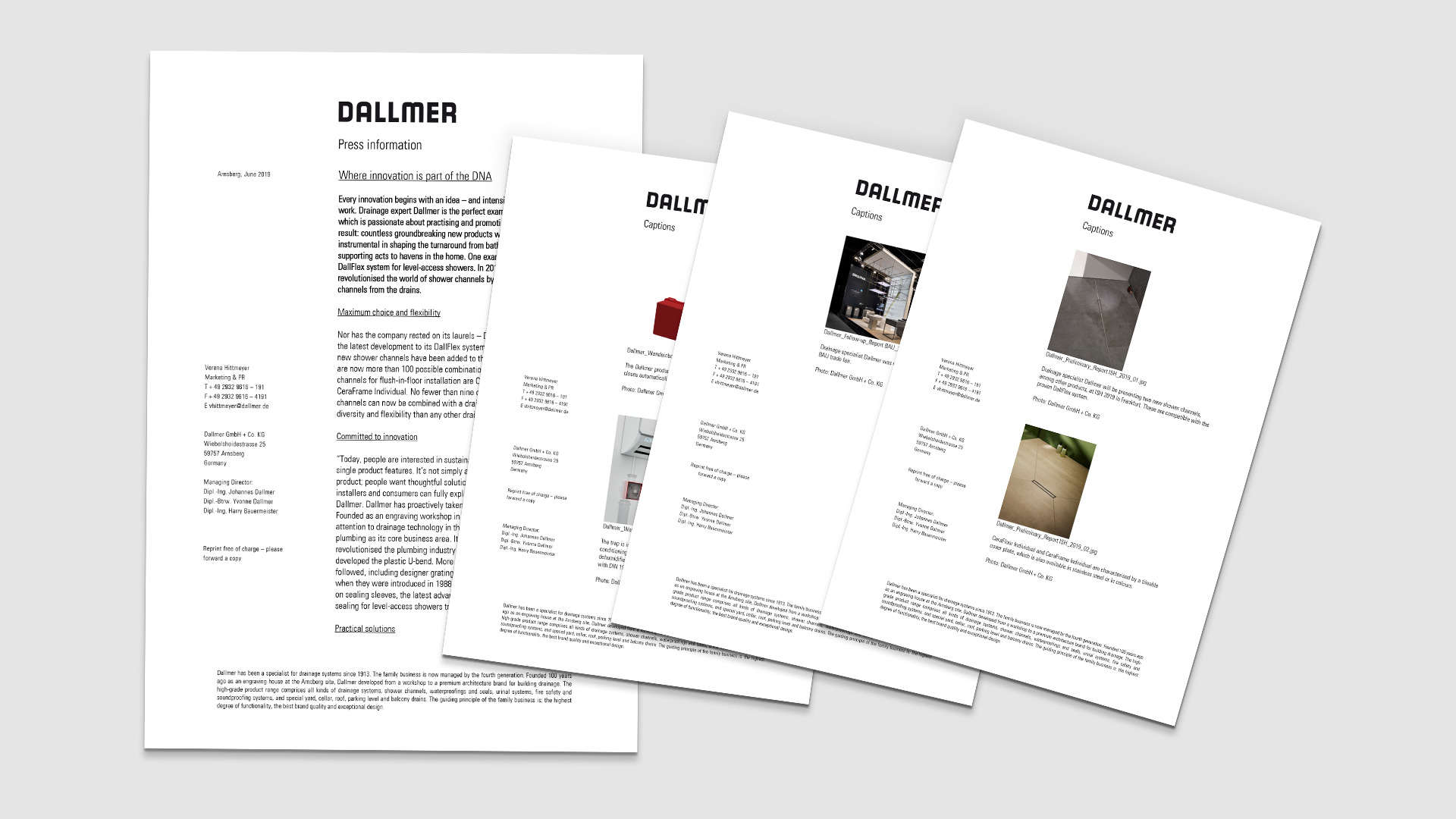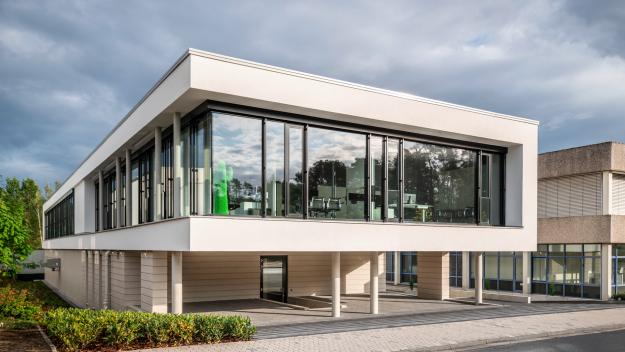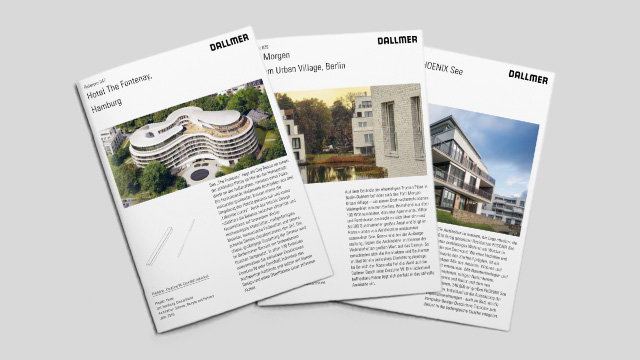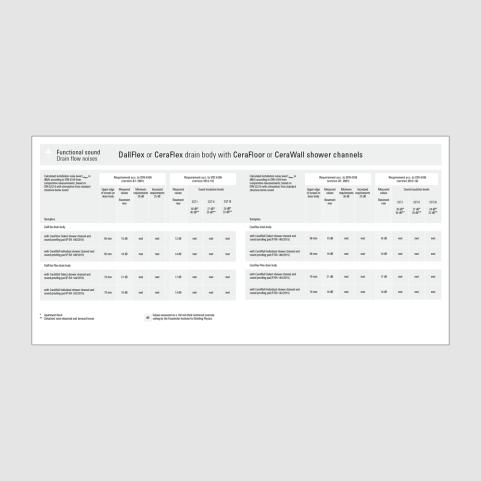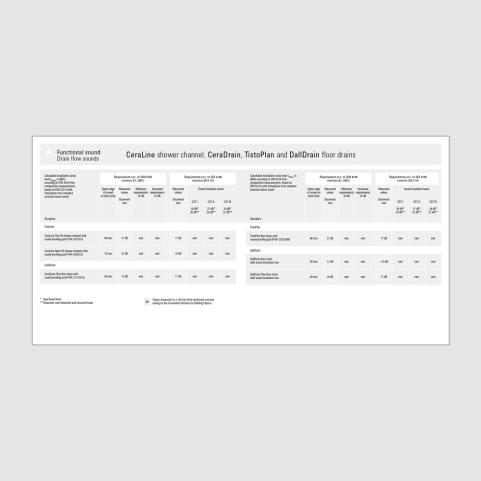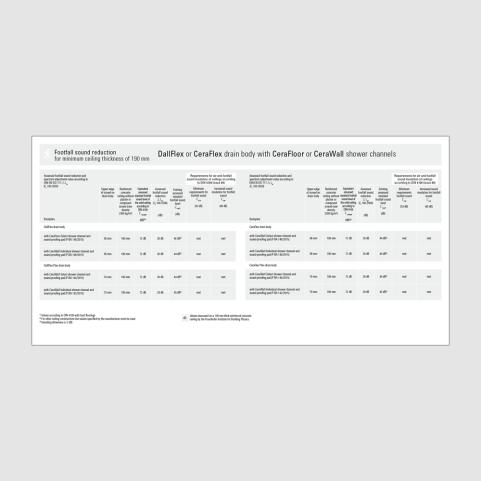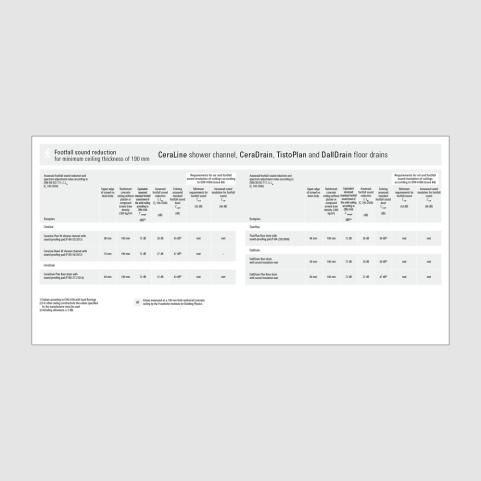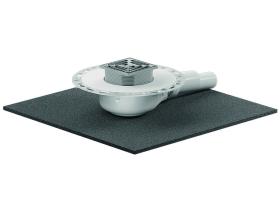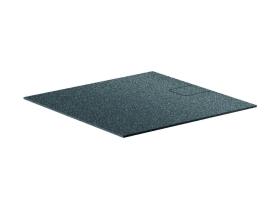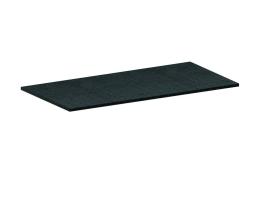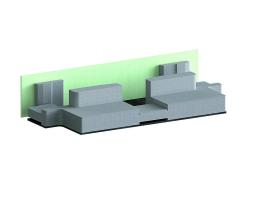Compact Knowledge - Sound insulation
At a glance
- Benefits of sound insulation
Sound insulation makes a major contribution towards the value stability of a building and the health of its residents / users. - Application
Sound insulation in drainage technology, level-access showers in particular. - Participants
Acting companies, architects, planners, manufacturers of building products, owners, users of residential buildings.
- Task of sound insulation in level-access showers
Protection against functional sound and footfall sound. - Relevant standards and guidelines
The standard DIN 4109 specifies the minimum standards for sound insulation, the VDI guideline 4100 formulates increased requirements. - Dallmer sound insulation values
Dallmer's drainage systems either meet or exceed the requirements of DIN 4109 and VDI 4100.
Sound and technical sound insulation
Sound insulation in drainage technology falls under the jurisdiction of building acoustics. Aims include protection against sounds from building technology systems, such as supply / wastewater pipes. Sound insulation products prevent / reduce sound transmission from the source to the ear of the unwilling listener. When it comes to the sound insulation of level-access showers, there are two types of sound: Functional sound and footfall sound.
Functional sound
Functional sound, also known as installation noise, includes flow noise, i.e. the sound of water flowing, and impact sound, such as that occurring when the water jet hits the shower floor. The volume of installation noise depends primarily on transmission from the wastewater pipe to the building structure. As it is impossible to avoid contact points between installation technology, drain and pipework, the task of sound insulation technology is to absorb functional sound as far as possible, thus preventing sound transmission.
Measured values Functional sound
Dallmer supplies drainage technology for level-access showers which meets the requirements of DIN 4109 and VDI 4100 for protection from functional sound. The DallFlex system family, the CeraLine shower channel and the CeraLine, TistoPlan and DallDrain floor drains all comply with the relevant regulations.
Footfall sound
Footfall sound is caused by the mechanical stimulation of steps, screed, tiles and bare flooring, such as walking or moving a chair. This sound is transmitted to the rooms below, partially as structure-borne sound via the floor and flanking components, and partially as airborne sound, which is why floors, and thus the entire floor structure in buildings, need to meet the requirements for airborne and footfall sound insulation. The minimum requirements are stipulated in the standard DIN 4109. The right floor structure – the mass and sound-absorbing properties of floating screed have proven particularly beneficial – and high-quality footfall sound insulation can significantly reduce footfall sound. Our footfall sound insulation is made of mineral and EPS insulation according to the respective test report. In this case, footfall sound can no longer be heard in the rooms below, or only very quietly.
Measured values Footfall sound reduction
Dallmer supplies drainage technology for level-access showers which meets the requirements of DIN 4109 and VDI 4100 for footfall sound reduction. The DallFlex system family, the CeraLine shower channel and the CeraLine, TistoPlan and DallDrain floor drains all comply with the relevant regulations.
System design & floor structure with sound-proofing pad + footfall sound insulation
Shown here with CeraWall Select + DallFlex drain body and DallFlex sound-proofing pad
(installation according to P-BA 148/2015 which meets the increased sound insulation requirements of DIN 4109 and VDI 4100)
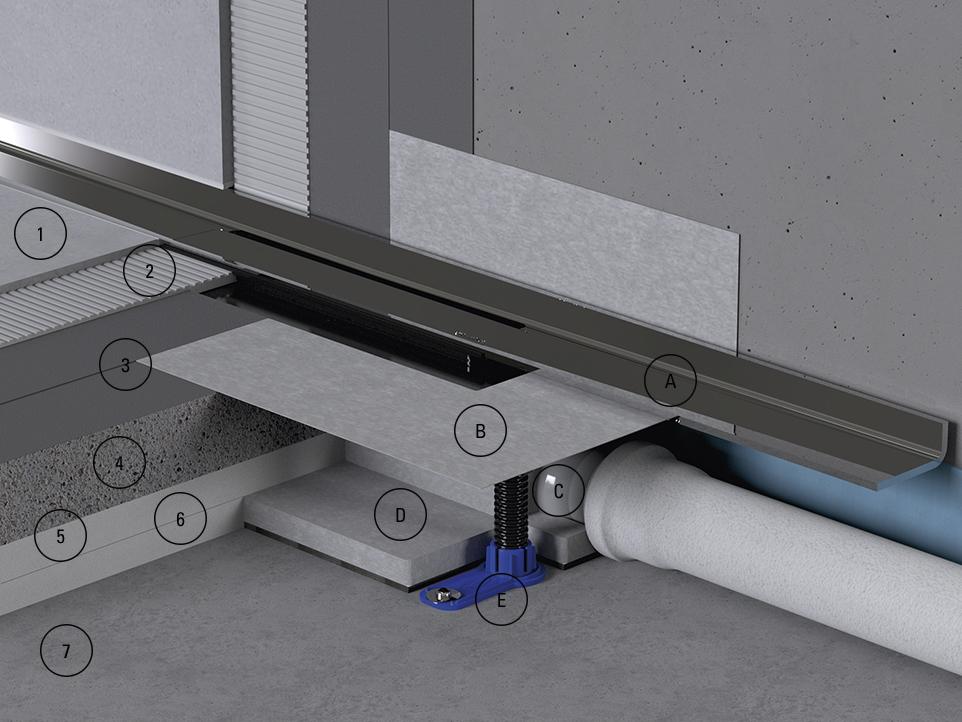
Floor structure
- Ceramic floor covering
- Tile adhesive in thin bed mortar
- Bonded waterproofing
- Screed
- Separating layer
- Footfall sound/thermal insulation
- Concrete surface
System design
A. CeraWall Select shower channel
B. Sealing sleeve
C. DallFlex drain body
D. Sound-proofing pad
E. Levelling feet
Installation products, such as the DallFlex sound-proofing pad shown above, separate the drain body from the surrounding screed and significantly dampen functional sound. For installation acc. to test report P-BA 146/2015 (for CeraFloor, Zentrix and CeraNiveau shower channels) or P-BA 148/2015 (for CeraWall shower channels) - suitable for meeting the increased sound insulation requirements according to DIN 4109 and VDI 4100.
DIN 4109 and VDI 4100
Two codes of practice are relevant for sound insulation: the DIN 4109 standard and VDI 4100 guideline. The DIN stipulates the minimum requirements for regular sound insulation, while the VDI guidelines define the requirements for increased sound insulation.
DIN 4109 – Sound insulation in high-rise buildings
Published by: DIN Deutsches Institut für Normung (German Institute for Standardisation)
Aim: The Regional Building Code requires that buildings are fitted with appropriate sound insulation in order to protect residents / users against unreasonable annoyances and harmful effects on their health. It specifies the minimum requirements, while supplementary sheet 2 also contains recommendations for increased sound insulation.
DIN 4109 is part of the construction law of the federal states. It is applicable in the housing sector, as well as in schools, hospitals, commercially rented accommodation and office blocks.
Limit values for functional sound
In the case of functional sound, the installation noise level LAFmax,n (LAFeq,n) is applicable. Installation noise level refers to the sound pressure level caused by the sanitary facilities, which is also a quantity for describing the intensity of the sound event. The increased requirements prohibit the installation noise level from exceeding 30 dB or 25 dB.
Limit values for footfall sound
When calculating footfall sound, L'n,w is the deciding factor. This is the assessed standard footfall sound, i.e. the sound that can be heard in the room to be insulated. The lower the standard footfall sound, the quieter it is in the room. DIN 4109 sets the minimum requirement of 53 dB as the maximum permissible sound pressure level, while the increased requirements stipulate 46 dB in multi-dwelling residences for ceilings located underneath bathrooms and toilets.
VDI directive 4100 "Sound insulation in high-rise buildings – apartments: assessment and proposals for increased sound insulation"
Published by: Verein Deutscher Ingenieure [Association of German Engineers]
Aim: The VDI guideline formulates increased requirements for sound insulation in order to increase privacy and life quality in apartments.
The VDI 4100 is specially tailored to the sound insulation of apartment blocks, or buildings designed for residential use, such as retirement homes, student halls of residence or nursing homes. According to VDI 4100, all rooms larger than 8 m2 and bathrooms of any size are considered in need of insulation. Unlike DIN 4109, sound insulation according to VDI 4100 must be contractually agreed if required.
Sound insulation levels acc. to VDI 4100
The VDI guideline defines three sound insulation levels, which are based on how the sound is registered in the receiving room:
- SST III: the sound is not considered disruptive.
- SST II: the sound is not generally considered disruptive.
- SST I: the sound is generally considered minimally disruptive.
The 3 key quantities for describing sound insulation according to VDI 4100
- DnT,W = airborne sound insulation
- L’nT,w = footfall sound insulation
- LAFmax,nT* = maximum level from building service installations
The last two quantities are particularly relevant to drainage technology. Which values require compliance depends on the type of building and whether it is a question of insulating other apartments against sound or sound insulation in one's own home.
Limit values for functional sound (LAFmax,nT*)
The guideline stipulates the maximum permissible sound pressure level for all building service installations, including water supply and wastewater systems.
* The equation LAFmax,nT already takes flanking transmission into account.
Sound insulation against third-party apartments
|
Sound insulation levels |
SSt I |
SSt II |
SSt III |
|
Apartment blocks |
≤ 30 dB |
≤ 27 dB |
≤ 24 dB |
|
Detached, semi-detached and |
≤ 30 dB |
≤ 25 dB |
≤ 22 dB |
Individual short-time noise peaks that occur when actuating fittings and devices (opening, closing, setting, interruption, etc.) must not exceed the values of SSt II and SSt III by more than 10 dB. This assumes use according to the designated purpose.
Sound insulation within apartments and detached houses
|
Sound insulation levels |
SSt EB I |
SSt EB II |
|
Building service installations of own premises |
≤ 35 dB |
≤ 30 dB |
Individual short-time noise peaks that occur when actuating fittings and devices (opening, closing, setting, interruption, etc.) must not exceed the values of SSt II and SSt III by more than 10 dB. This assumes use according to the designated purpose.
Limit values for footfall sound (L’nT,w)
|
VDI 4100:2012-10 |
||
|
L'nT,w |
Footfall sound insulation in apartment blocks |
|
|
[dB] |
Footfall sound is |
|
|
≤ 37 |
SSt III |
not considered disruptive |
|
≤ 44 |
SSt II |
not generally considered disruptive |
|
≤ 51 |
SST I |
generally considered minimally disruptive |
|
VDI 4100:2012-10 |
||
|
L'nT,w |
Footfall sound insulation in semi-detached and terraced properties |
|
|
[dB] |
Footfall sound is |
|
|
≤ 32 |
SSt III |
not considered disruptive |
|
≤ 39 |
SSt II |
not generally considered disruptive |
|
≤ 46 |
SST I |
generally considered minimally disruptive |
Glossary
The standard "DIN 4109 – Sound insulation in high-rise buildings" stipulates the minimum requirements for regular sound insulation.
Dynamic stiffness describes the effectiveness of insulation material, i.e. how well it absorbs sound. Generally speaking, lightweight, low-density materials are best suited for this task. A low value indicates good sound insulation properties.
Functional sounds include flow noise, i.e. the sound of water flowing, and the sounds that occur when the water jet hits the shower floor.
The sound pressure level caused by sanitary installations.
Relevant products
Downloads
-
 Compact knowledge - Sound insulation - Print preview
PDF, 1231 KB
Compact knowledge - Sound insulation - Print preview
PDF, 1231 KB
Further downloads
Brochures, references, data sheets, etc. are available in our Download section.
Dated: September 2020
Drainage by design.
Since 1913
Registered Address
Dallmer Ltd.
c/o Seago and Stopps Limited
61 Station Road
Sudbury, Suffolk CO 10 2 SP
United Kingdom
Co. Reg. No.:
Business Address
Dallmer Ltd.
c/o Dallmer GmbH + Co. KG
Wiebelsheidestrasse 25
59757 Arnsberg
Germany
slsdllmrcm
ccntsdllmrcm
dallmer.com
Show address
Registered Address
Dallmer Ltd.
c/o Seago and Stopps Limited
61 Station Road
Sudbury, Suffolk CO 10 2 SP
United Kingdom
Co. Reg. No.:
Business Address
Dallmer Ltd.
c/o Dallmer GmbH + Co. KG
Wiebelsheidestrasse 25
59757 Arnsberg
Germany
slsdllmrcm
ccntsdllmrcm
dallmer.com

